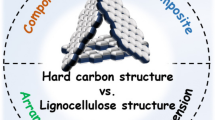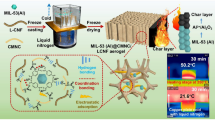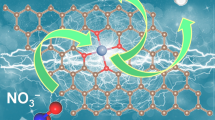Abstract
In this work, we aimed to investigate the potential use of nanocellulose as a solid electrolyte membrane for the direct methanol fuel cell application. Nanocellulose membrane was fabricated using the vacuum filtration of cellulose nanofiber suspension extracted from Para rubber wood sawdust. The membrane was impregnated with sulfosuccinic acid (SSA) and then activated at 120 °C for 1 h in hot pressing machine. The SSA concentrations used were in a range of 0.1–10.0%w/v. Effects of sulfosuccinic acid on methanol permeability, ion exchange capacities (IEC), water uptake, oxidative and thermal stabilities, and mechanical properties were also investigated. It was found from an FTIR technique and confirmed by a solid-state 13C CP-MAS NMR result that esterification between –COOH groups of SSA and –OH groups of nanocellulose occurred, leading to crosslinking of nanocellulose as well as the increased hydrophilic ionic domains (free –COOH and –SO3H) in the membrane. IEC of the neat nanocellulose and the nanocellulose membranes modified with SSA ranged from 0.005 to 0.069 mmol/g. The water uptake ranged from 28 to 61%. The results showed that the amounts of SSA used in modification influenced the proton conduction and methanol transport properties of nanocellulose. Based on our research, the sulfonate-modified nanocelluloses prepared by simple pre-impregnation with SSA showed better methanol barrier property and proton conductivity than the neat nanocellulose. Our SSA-modified nanocellulose membranes are promising to be developed and utilized as ionic biodegradable membranes in DMFA applications.














Similar content being viewed by others
References
Zhong S, Cui X, Cai H, Fu T, Zhao C, Na H (2007) Crosslinked sulfonated poly(ether ether ketone) proton exchange membranes for direct methanol fuel cell applications. J Power Sources 164(1):65–72
Silva VS, Schirmer J, Reissner R, Ruffmann B, Silva H, Mendes A, Madeira LM, Nunes SP (2005) Proton electrolyte membrane properties and direct methanol fuel cell performance: II. Fuel cell performance and membrane properties effects. J Power Sources 140(1):41–49
Silva VS, Ruffmann B, Vetter S, Mendes A, Madeira LM, Nunes SP (2005) Characterization and application of composite membranes in DMFC. Catal Today 104(2):205–212
Carrette L, Friedrich KA, Stimming U (2001) Fuel Cells – Fundamentals and Applications. Fuel Cells 1:5–39
Peighambardoust SJ, Rowshanzamir S, Amjadi M (2010) Review of the proton exchange membranes for fuel cell applications. Int J Hydrogen Energy 35(17):9349–9384
Kraytsberg A, Ein-Eli Y (2014) Review of advanced materials for proton exchange membrane fuel cells. Energy Fuels 28(12):7303–7330
Kim DS, Park HB, Rhim JW, Lee YM (2005) Proton conductivity and methanol transport behavior of cross-linked PVA/PAA/silica hybrid membranes. Solid State Ionics 176(1):117–126
Pivovar BS, Wang Y, Cussler EL (1999) Pervaporation membranes in direct methanol fuel cells. J Membr Sci 154(2):155–162
Rhim J-W, Park HB, Lee C-S, Jun J-H, Kim DS, Lee YM (2004) Crosslinked poly(vinyl alcohol) membranes containing sulfonic acid group: proton and methanol transport through membranes. J Membr Sci 238(1):143–151
Ma J, Sahai Y (2013) Chitosan biopolymer for fuel cell applications. Carbohydr Polym 92(2):955–975
Shaari N, Kamarudin SK (2015) Chitosan and alginate types of bio-membrane in fuel cell application: an overview. J Power Sources 289:71–80
Nishiyama Y, Langan P, Chanzy H (2002) Crystal structure and hydrogen-bonding system in cellulose Iβ from synchrotron X-ray and neutron fiber diffraction. J Am Chem Soc 124(31):9074–9082
Jonas R, Farah LF (1998) Production and application of microbial cellulose. Polym Degrad Stab 59(1):101–106
Habibi Y (2014) Key advances in the chemical modification of nanocelluloses. Chem Soc Rev 43(5):1519–1542
Liimatainen H, Visanko M, Sirviö J, Hormi O, Niinimäki JJC (2013) Sulfonated cellulose nanofibrils obtained from wood pulp through regioselective oxidative bisulfite pre-treatment. Cellulose 20(2):741–749
Missoum K, Belgacem MN, Bras J (2013) Nanofibrillated cellulose surface modification: a review. Materials (Basel, Switzerland) 6(5):1745–1766
Seo JA, Kim JC, Koh JK, Ahn SH, Kim JHJI (2009) Preparation and characterization of crosslinked cellulose/sulfosuccinic acid membranes as proton conducting electrolytes. Ionics 15(5):555–560
Pandey LK, Saxena C, Dubey V (2005) Studies on pervaporative characteristics of bacterial cellulose membrane. Sep Purif Technol 42(3):213–218
Bayer T, Cunning BV, Selyanchyn R, Nishihara M, Fujikawa S, Sasaki K, Lyth SM (2016) High Temperature proton conduction in nanocellulose membranes: paper fuel cells. Chem Mater 28(13):4805–4814
Sriruangrungkamol A, Wongyao N, Chonkaew W (2019) Preparation and characterization of SIPA-modified CNF membranes for fuel cell applications. In: Paper presented at the 7th international conference on bio - based polymers (ICBP 2019). Thailand Science Park Convention Center and Chaloem Rajakumari 60 Building (CHAMCHURI 10), Chulalongkorn University, pp 1–6
Ongthip L, Chonkaew W (2018) Nanofibrillar cellulose from para rubber wood sawdust as reinforcement in polylactic acid composites. Srinakharinwirot S J 34(1):264–275
Moriana R, Vilaplana F, Ek M (2016) Cellulose nanocrystals from forest residues as reinforcing agents for composites: a study from macro- to nano-dimensions. Carbohydr Polym 139:139–149
Siqueira G, Bras J, Dufresne A (2009) Cellulose whiskers versus microfibrils: influence of the nature of the nanoparticle and its surface functionalization on the thermal and mechanical properties of nanocomposites. Biomacromol 10(2):425–432
Siqueira G, Abdillahi H, Bras J, Dufresne A (2010) High reinforcing capability cellulose nanocrystals extracted from syngonanthus nitens (Capim Dourado). Cellulose 17(2):289–298
Azizi Samir MA, Alloin F, Dufresne A (2005) Review of recent research into cellulosic whiskers, their properties and their application in nanocomposite field. Biomacromol 6(2):612–626
Beck-Candanedo S, Roman M, Gray DG (2005) Effect of reaction conditions on the properties and behavior of wood cellulose nanocrystal suspensions. Biomacromol 6(2):1048–1054
Dong XM, Revol J-F, Gray DG (1998) Effect of microcrystallite preparation conditions on the formation of colloid crystals of cellulose. Cellulose 5(1):19–32
Segal L, Creely JJ, Martin AE, Conrad CM (1959) An empirical method for estimating the degree of crystallinity of native cellulose using the x-ray diffractometer. Text Res J 29(10):786–794
Fattahi Meyabadi T, Dadashian F, Mir Mohamad Sadeghi G, Ebrahimi Zanjani Asl H (2014) Spherical cellulose nanoparticles preparation from waste cotton using a green method. Powder Technol 261:232–240
Changkhamchom S, Sirivat A (2013) Polymer electrolyte membrane based on sulfonated poly(Ether Ketone Ether Sulfone) (S-PEKES) with low methanol permeability for direct methanol fuel cell application. Polym Plast Technol Eng 52(1):70–79
Vetter S, Ruffmann B, Buder I, Nunes SP (2005) Proton conductive membranes of sulfonated poly(ether ketone ketone). J Membr Sci 260(1):181–186
Mukoma P, Jooste BR, Vosloo HCM (2004) A comparison of methanol permeability in Chitosan and Nafion 117 membranes at high to medium methanol concentrations. J Membr Sci 243(1):293–299
Shang XY, Shu D, Wang SJ, Xiao M, Meng YZ (2007) Fluorene-containing sulfonated poly(arylene ether 1,3,4-oxadiazole) as proton-exchange membrane for PEM fuel cell application. J Membr Sci 291(1):140–147
Eichhorn SJ, Dufresne A, Aranguren M, Marcovich NE, Capadona JR, Rowan SJ, Weder C, Thielemans W, Roman M, Renneckar S, Gindl W, Veigel S, Keckes J, Yano H, Abe K, Nogi M, Nakagaito AN, Mangalam A, Simonsen J, Benight AS, Bismarck A, Berglund LA, Peijs T (2010) Review: current international research into cellulose nanofibres and nanocomposites. J Mater Sci 45:1–33
Morán JI, Alvarez VA, Cyras VP, Vázquez AJC (2008) Extraction of cellulose and preparation of nanocellulose from sisal fibers. Cellulose 15(1):149–159
Alamri H, Low IM (2012) Effect of water absorption on the mechanical properties of n-SiC filled recycled cellulose fibre reinforced epoxy eco-nanocomposites. Polym Testing 31(6):810–818
Biswal DR, Singh RP (2004) Characterisation of carboxymethyl cellulose and polyacrylamide graft copolymer. Carbohydr Polym 57(4):379–387
Wongjaiyen T, Brostow W, Chonkaew W (2018) Tensile properties and wear resistance of epoxy nanocomposites reinforced with cellulose nanofibers. Polym Bull 75(5):2039–2051
Sain M, Panthapulakkal S (2006) Bioprocess preparation of wheat straw fibers and their characterization. Ind Crops Prod 23(1):1–8
Himmelsbach DS, Khalili S, Akin DE (2002) The use of FT-IR microspectroscopic mapping to study the effects of enzymatic retting of flax (Linum usitatissimum L.) stems. J Sci Food Agric 82(7):685–696
Sun XF, Xu F, Sun RC, Fowler P, Baird MS (2005) Characteristics of degraded cellulose obtained from steam-exploded wheat straw. Carbohydr Res 340(1):97–106
Ribeiro-Viana RM, Faria-Tischer PC, Tischer CA (2016) Preparation of succinylated cellulose membranes for functionalization purposes. Carbohydr Polym 148:21–28
Lowman DW (1998) Characterization of cellulose esters by solution-state and solid-state NMR spectroscopy. In: Cellulose derivatives, vol 688. In: ACS symposium series, vol 688. American Chemical Society, pp 131–162
Zhao G, Wang F, Lang X, He B, Li J, Li X (2017) Facile one-pot fabrication of cellulose nanocrystals and enzymatic synthesis of its esterified derivative in mixed ionic liquids. RSC Adv. 7(43):27017–27023
Karim Z, Claudpierre S, Grahn M, Oksman K, Mathew AP (2016) Nanocellulose based functional membranes for water cleaning: Tailoring of mechanical properties, porosity and metal ion capture. J Membr Sci 514:418–428
Henriksson M, Berglund LA, Isaksson P, Lindström T, Nishino T (2008) Cellulose nanopaper structures of high toughness. Biomacromol 9(6):1579–1585
Voisin H, Bergström L, Liu P, Mathew AP (2017) Nanocellulose-based materials for water purification. Nanomaterials (Basel, Switzerland) 7(3):57
Wu H, Cao Y, Shen X, Li Z, Xu T, Jiang Z (2014) Preparation and performance of different amino acids functionalized titania-embedded sulfonated poly (ether ether ketone) hybrid membranes for direct methanol fuel cells. J Membr Sci 463:134–144
Guccini V, Carlson A, Yu S, Lindbergh G, Lindström RW, Salazar-Alvarez G (2019) Highly proton conductive membranes based on carboxylated cellulose nanofibres and their performance in proton exchange membrane fuel cells. J Mater Chem A 7(43):25032–25039
Dashtimoghadam E, Hasani-Sadrabadi MM, Moaddel H (2010) Structural modification of chitosan biopolymer as a novel polyelectrolyte membrane for green power generation. Polym Adv Technol 21(10):726–734
Zawodzinski TA, Neeman M, Sillerud LO, Gottesfeld S (1991) Determination of water diffusion coefficients in perfluorosulfonate ionomeric membranes. J Phys Chem 95(15):6040–6044
Sadeghi RR, Cheng H-P (1999) The dynamics of proton transfer in a water chain. J Chem Phys 111(5):2086–2094
Zhang H, Stanis R, Song Y, Hu W, Cornelius C, Shi Q, Liu B, Guiver M (2017) Fuel cell performance of pendent methylphenyl sulfonated poly(ether ether ketone ketone)s. J Power Sources 368:30–37
Kim J, Jang J-S, Peck D-H, Lee B, Yoon S-H, Jung D-H (2016) Methanol-tolerant platinum-palladium catalyst supported on nitrogen-doped carbon nanofiber for high concentration direct methanol fuel cells. Nanomaterials (Basel) 6(8):148
Mohy Eldin M, Elmageed M, Omer A, Tamer T, Youssef ME, Ghonim R (2016) Development of novel phosphorylated cellulose acetate polyelectrolyte membranes for direct methanol fuel cell application. Int J Electrochem Sci 11(2016):3467–3491
Mohy Eldin M, Elmageed M, Omer A, Tamer T, Youssef ME, Ghonim R (2016) Novel proton exchange membranes based on sulfonated cellulose acetate for fuel cell applications: preparation and characterization. Int J Electrochem Sci 11(2016):10150–10171
Mohy Eldin M, Elmageed M, Omer A, Tamer T, Youssef ME, Ghonim R (2017) Novel aminated cellulose acetate membranes for direct methanol fuel cells (DMFCs). Int J Electrochem Sci 12(2017):4301–4318
Changkhamchom S, Sirivat A (2014) High proton conductivity ZSM-5/sulfonated poly(ether ketone ether sulfone) (S-PEKES) composite proton exchange membrane for using in direct methanol fuel cell. Solid State Ionics 263:161–166
Tutgun MS, Sinirlioglu D, Celik SU, Bozkurt A (2015) Investigation of nanocomposite membranes based on crosslinked poly(vinyl alcohol)–sulfosuccinic acid ester and hexagonal boron nitride. J Polym Res 22(4):47
Kim DS, Park HB, Rhim JW, Moo Lee Y (2004) Preparation and characterization of crosslinked PVA/SiO2 hybrid membranes containing sulfonic acid groups for direct methanol fuel cell applications. J Membr Sci 240(1):37–48
Chen P, Chen X, An Z (2012) Covalently and ionically crosslinked sulfonated poly(arylene ether ketone)s as proton exchange membranes. Polym Bull 68(5):1369–1386
Liao H, Zhang K, Tong G, Xiao G, Yan D (2014) Sulfonated poly(arylene ether phosphine oxide)s with various distributions and contents of pendant sulfonic acid groups synthesized by direct polycondensation. Polym Chem 5(2):412–422
Acknowledgements
The authors would like to give a sincere thank the Capacity Building Program for New Researcher 2018 from National Research Council of Thailand (NRCT) for research funding, the KMUTT 55th Anniversary Commemorative Fund from King Mongkut's University of Technology Thonburi (KMUTT), and Faculty of Science, KMUTT for the scholarship given to S.A.
Author information
Authors and Affiliations
Corresponding author
Additional information
Publisher's Note
Springer Nature remains neutral with regard to jurisdictional claims in published maps and institutional affiliations.
Rights and permissions
About this article
Cite this article
Sriruangrungkamol, A., Chonkaew, W. Modification of nanocellulose membrane by impregnation method with sulfosuccinic acid for direct methanol fuel cell applications. Polym. Bull. 78, 3705–3728 (2021). https://doi.org/10.1007/s00289-020-03289-y
Received:
Revised:
Accepted:
Published:
Issue Date:
DOI: https://doi.org/10.1007/s00289-020-03289-y




